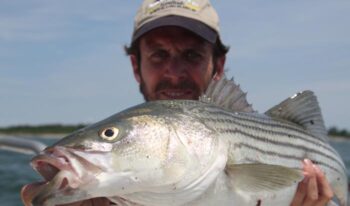
Fooled by a fly. Long Island, New York. A North Fork flats striper that cooperated. Capt. Andrew Derr image.
In the world of trout fly fishing, as opposed to saltwater fly fishing, there isn’t the need to know as many knots
By Skip Clement
[dropcap]I[/dropcap]n trout and bass fishing there is no toothy fish, need for wire, bite guard, shock tippets, or serious considerations for joining significantly different line diameters or types of materials. For example, monofilament, gel-spun, braid to one another or 20-pound test mono to wire, as would be the case if fly fishing in the salt. That’s not an opinion; it’s just a fact.
But knot tying is never to be dismissed as not as important in one venue versus another venue or one fish versus another game fish. A terminal connection is always critical. Product choices, sure, plenty of opinion room there.
For me, the occasion of connecting to a loop or doubled line, and especially differing materials (mono to a wire), was always a Jimmy Albright knot in its original tie. It was what I was taught. It was what never failed. It is what I can tie in my sleep.
So, why the Bristol Knot, or No Name Knot as it’s sometimes called?
Well, it’s a stronger knot than a Surgeons or Albright, according to the International Game Fish Association’s (IGFA) Instron Machine tests, and it’s easier to tie.
There are several videos on tying the No Name/Bristol knot, but Jason Schratwieser’s IGFA telling is probably the best – take a look:
NOTE: With the No Name/Bristol knot you should add turns with fluorocarbon (double the turns), and reverse the turns with braid (five out and five back).
[youtube id=”s7OBDZWI8yQ” width=”620″ height=”360″]


